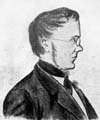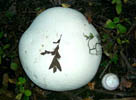(pl. brown rots, white rots)
Terms discussed: palo podrido, selective delignification
Wood has two main components that outlive the plant that created it: cellulose and lignin. Many fungi digest only one of these components, leaving the other one behind. A lignin-digesting fungus leaves the white cellulose behind; this is called a white rot. There are actually two kinds of white rots: in one, the fungus only digests the the lignin and hemicellulose, leaving the cellulose behind (selective delignification); in the other, the fungus digests all the wood components at a more or less equal rate - - presumably there is just more of the cellulose to begin with, so it is left over at the end.
Back to top
Wood that has been processed by a white-rotting fungus is soft and fibrous, and is better suited than normal wood for pulping into paper. Under the name palo podrido, it is used as food for cattle in parts of Chile. And it is one of the candidates for touchwood, a kind of tinder.
Back to top
A brown rot fungus selectively removes the cellulose compounds from the wood, leaving the brown lignin behind as humus.











